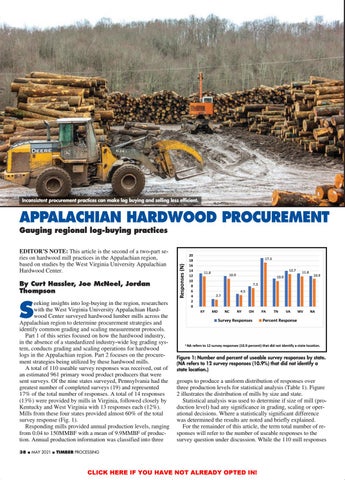TPmay21pgs_cs.qxp_Layout 1 4/20/21 8:16 AM Page 38
Inconsistent procurement practices can make log buying and selling less efficient.
APPALACHIAN HARDWOOD PROCUREMENT Gauging regional log-buying practices
EDITOR’S NOTE: This article is the second of a two-part series on hardwood mill practices in the Appalachian region, based on studies by the West Virginia University Appalachian Hardwood Center.
By Curt Hassler, Joe McNeel, Jordan Thompson
S
eeking insights into log-buying in the region, researchers with the West Virginia University Appalachian Hardwood Center surveyed hardwood lumber mills across the Appalachian region to determine procurement strategies and identify common grading and scaling measurement protocols. Part 1 of this series focused on how the hardwood industry, in the absence of a standardized industry-wide log grading system, conducts grading and scaling operations for hardwood logs in the Appalachian region. Part 2 focuses on the procurement strategies being utilized by these hardwood mills. A total of 110 useable survey responses was received, out of an estimated 961 primary wood product producers that were sent surveys. Of the nine states surveyed, Pennsylvania had the greatest number of completed surveys (19) and represented 17% of the total number of responses. A total of 14 responses (13%) were provided by mills in Virginia, followed closely by Kentucky and West Virginia with 13 responses each (12%). Mills from these four states provided almost 60% of the total survey response (Fig. 1). Responding mills provided annual production levels, ranging from 0.04 to 150MMBF with a mean of 9.9MMBF of production. Annual production information was classified into three 38
■
MAY 2021
■
Figure 1: Number and percent of useable survey responses by state. (NA refers to 12 survey responses (10.9%) that did not identify a state location.)
groups to produce a uniform distribution of responses over three production levels for statistical analysis (Table 1). Figure 2 illustrates the distribution of mills by size and state. Statistical analysis was used to determine if size of mill (production level) had any significance in grading, scaling or operational decisions. Where a statistically significant difference was determined the results are noted and briefly explained. For the remainder of this article, the term total number of responses will refer to the number of useable responses to the survey question under discussion. While the 110 mill responses
TIMBER PROCESSING
CLICK HERE IF YOU HAVE NOT ALREADY OPTED IN!







